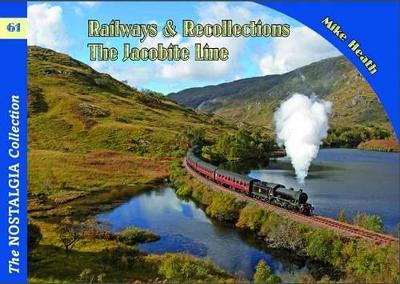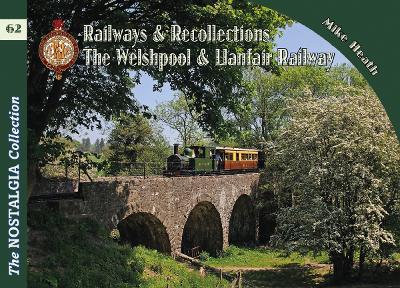Recollections
2 primary works
Book 61
The 42 mile long line between Fort William and Mallaig is one of the greatest railway journeys in the world. As it weaves its way through the beauty of the West Highlands, skirting lochs, clinging to hillsides, crossing over rivers and glens, through cuttings and tunnels it passes many natural and man-made 'extremes' along the way.The journey starts beneath Ben Nevis, the highest mountain in Britain, at the largest town in the West Highlands, Fort William. On the outskirts of the town it passes over the Caledonian Canal on a swing bridge at the foot of Neptune's Staircase, a set of eight locks which is the longest staircase lock in Great Britain. As it heads towards the banks of Loch Eil, the western sea entrance of the Caledonian Canal comes into view at Corpach.Glenfinnan is famous for one of the world's most recognisable structures, the twenty-one arch concrete viaduct immortalised in the 'Harry Potter' films. From it, the view along Loch Shiel, beyond the monument, is arguably the finest from any railway. The station houses a fascinating museum dedicated to the history of the line.The journey continues over the line's summit and along the banks of Loch Eilt, passed Lochailort, The White Chapel at Polnish and Loch Dubh.
The first glimpse of the Atlantic Ocean comes as the second concrete viaduct, at Loch nan Uamh, is crossed. Heading inland the 1 in 48 Beasdale Bank is tackled before arriving at Arisaig, the farthest west station on British Railways. Here there are views across to Loch nan Ceall.As the train approaches the penultimate station on the line at Morar, passengers are afforded stunning views of the white sands the area is famous for and the line crosses another viaduct that spans the River Morar. This is thought to be the shortest river in the British Isles and flows from Loch Morar, the deepest freshwater Loch in the United Kingdom. Journeys end is Mallaig, the main commercial fishing port on the west coast of Scotland and terminal for a network of ferry services to the Western Isles; most notably the Isle of Skye. Steam hauled excursions have been a regular sight along the route since 1984 and this photographic album captures the experience of a trip along this line and the wild and wonderful landscape through which it passes.
The first glimpse of the Atlantic Ocean comes as the second concrete viaduct, at Loch nan Uamh, is crossed. Heading inland the 1 in 48 Beasdale Bank is tackled before arriving at Arisaig, the farthest west station on British Railways. Here there are views across to Loch nan Ceall.As the train approaches the penultimate station on the line at Morar, passengers are afforded stunning views of the white sands the area is famous for and the line crosses another viaduct that spans the River Morar. This is thought to be the shortest river in the British Isles and flows from Loch Morar, the deepest freshwater Loch in the United Kingdom. Journeys end is Mallaig, the main commercial fishing port on the west coast of Scotland and terminal for a network of ferry services to the Western Isles; most notably the Isle of Skye. Steam hauled excursions have been a regular sight along the route since 1984 and this photographic album captures the experience of a trip along this line and the wild and wonderful landscape through which it passes.
Book 62
The W&LLR opened in 1903 to link the rural community of Llanfair Caereinion with the historic market town of Welshpool. A 2ft. 6in. gauge light railway had been chosen to keep the costs of construction much lower than those associated with a standard gauge line. Furthermore, it was more suitable for the tight curves and steep gradients of the route and allowed the line to follow the contours of the countryside. Passenger services struggled to operate economically from day one and only lasted until 1931. However this sturdy little railway continued to help the communities of the Banwy Valley transport their goods, sheep and cattle to market until competition from the motor lorry won out and goods services ceased in November 1956. The preservation movement, although in its infancy, had already taken steps to preserve the Talyllyn Railway and an equally ambitious band of W&LLR enthusiasts embarked on saving their own local line. Their efforts were rewarded when the 1962 formed Welshpool & Llanfair Light Railway Preservation Society reopened the first section of railway from Llanfair Caereinion as far as Castle Caereinion.
With the section of the line that ran through Welshpool Town centre lost to preservation, the group redeveloped the area at Raven Square to create a new terminus. Services reached there in 1981. From that time visitors have been treated to a gentle steam hauled 8 mile journey through some of the most picturesque scenery in Wales. The railway's unique locomotive collection has developed and now embraces examples from three continents including the W&LLR's two original locos built for the line's 1903 opening, by Beyer, Peacock & Co. Ltd. Their coaching stock comprises turn of the century balcony ended saloons from Austria, 1950s built bogies from Hungary and 1960's stock from Sierra Leone. They have also invested in the construction of three replica coaches built to the specification and details of those that operated on the original line. This photographic album captures the essence of the Welshpool & Llanfair Railway which whilst having a decidedly foreign feel to it, continues to retain the traditional atmosphere of a Welsh rural light railway.
With the section of the line that ran through Welshpool Town centre lost to preservation, the group redeveloped the area at Raven Square to create a new terminus. Services reached there in 1981. From that time visitors have been treated to a gentle steam hauled 8 mile journey through some of the most picturesque scenery in Wales. The railway's unique locomotive collection has developed and now embraces examples from three continents including the W&LLR's two original locos built for the line's 1903 opening, by Beyer, Peacock & Co. Ltd. Their coaching stock comprises turn of the century balcony ended saloons from Austria, 1950s built bogies from Hungary and 1960's stock from Sierra Leone. They have also invested in the construction of three replica coaches built to the specification and details of those that operated on the original line. This photographic album captures the essence of the Welshpool & Llanfair Railway which whilst having a decidedly foreign feel to it, continues to retain the traditional atmosphere of a Welsh rural light railway.

